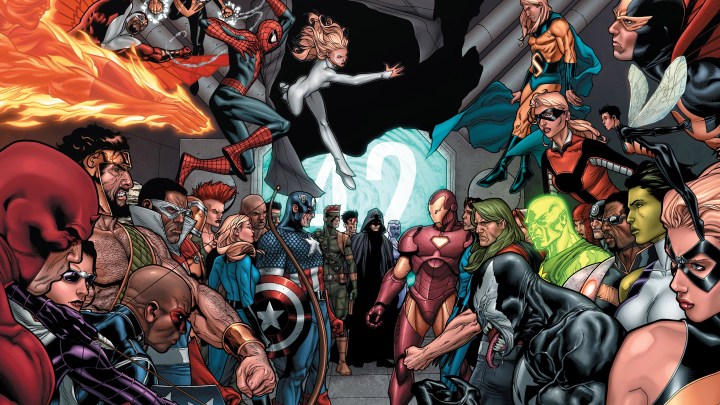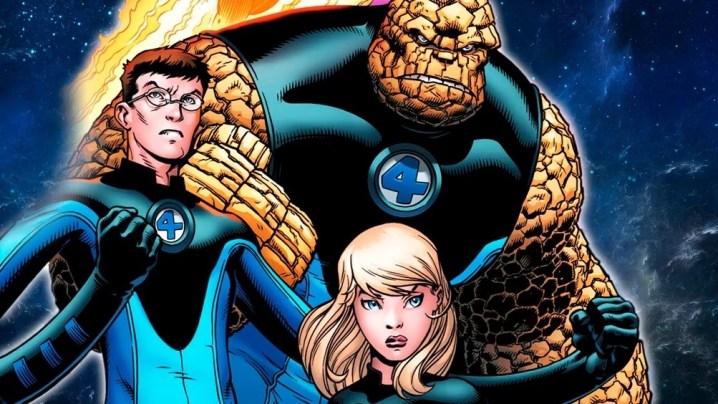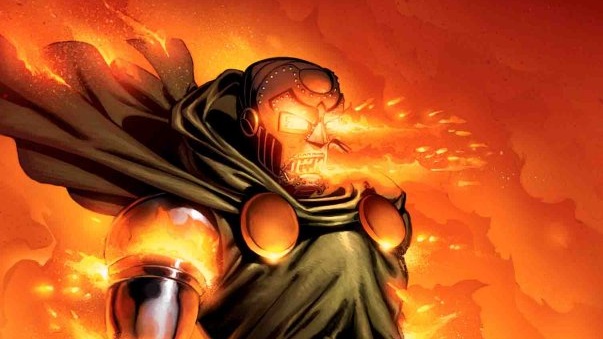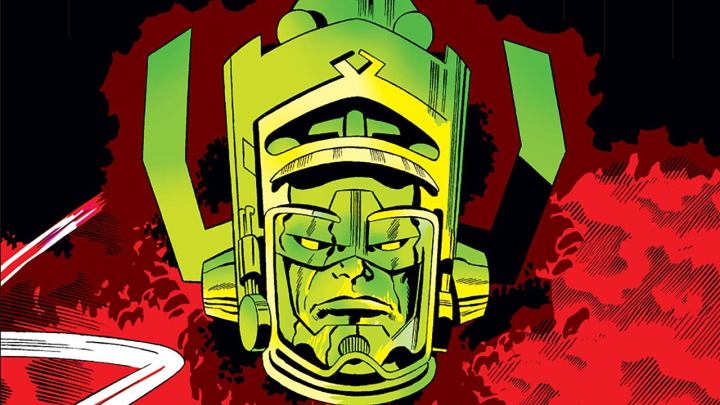As one of Marvel’s premier superhero teams, the Fantastic Four stands as a landmark assembly of powerful human characters altered by cosmic rays that use their gifts for the good of humanity. Reed Richards, Susan Storm, Johnny Storm, and Ben Grimm became Mister Fantastic, Invisible Woman, the Human Torch, and the Thing, respectively. Despite the highly fantastical (pun intended) powers of this quartet, such as Mister Fantastic’s ability to stretch his body into any shape or the Thing’s super strength and imperviousness thanks to his skin made of stone, the Fantastic Four hasn’t been one of Marvel’s more popular properties as of late. In fact, all of the attempts at feature film adaptations of the team have ranged from mediocre to abysmal at best.
- 10. Civil War
- 9. Life Story
- 8. Ultimate Fantastic Four
- 7. This Man… This Monster! (Fantastic Four issue No. 51)
- 6. Three (Fantastic Four issues No. 583-588)
- 5. The Black Panther! (Fantastic Four Issue issue No. 52)
- 4. The Trial Of Reed Richards (Fantastic Four issue No. 262)
- 3. The Fantastic Four (Fantastic Four issue No. 1)
- 2. Unthinkable (Fantastic Four vol. 3, issues No. 67-70)
- 1. The Galactus Trilogy (Fantastic Four issues No. 48-50)
Still, die-hard Marvel fans recognize that the Fantastic Four helped establish the entire idea behind superhero team-ups. There’s nothing quite as spectacular as watching an ensemble of superpowered heroes going to work on the bad guys simultaneously. And regardless of the property’s cinematic failings, there are actually a number of incredible Fantastic Four stories out there. With that in mind, we’re here to help you find the best of the best and rank them while we’re at it.
10. Civil War

This all-encompassing event written by Mark Millar was a game-changer across the entire Marvel Universe. Much like it’s film adaptation, the events of Civil War reverberated through many succeeding storylines in Marvel comics. Like almost all of Marvel’s heroes at the time, the Fantastic Four found themselves mixed up in the grand debate between freedom and security. As the U.S. government pushes a unilateral mandate called the Superhuman Registration Act, the heroes of the world are torn. Iron Man and Captain America wind up representing either side of the issue. The former is supportive of the legislation, while the latter opposes its authoritarian implications.
Reed Richards, the brainiac of the F4 crew, sides with Tony on the issue, which causes a bitter division among the famed superhero group. In fact, Reed’s partner and spouse at the time, Sue Storm, eventually opposes the mandate and joins Captain America in the fight against it. This ultimately fractures their marriage. Furthermore, Civil War demonstrates the moral gray area at the heart of these issues as we witness Reed adopt an authoritarian attitude and become willing to imprison his fellow cohorts who oppose the Act in the Negative Zone. It might not be the Fantastic Four’s best moment, but it’s a dramatic story that illustrates a very human conflict: politics.
9. Life Story

Like the title implies, Life Story puts the many years of Fantastic Four adventures into a saga beginning with their debut in the 1960s. The first issue introduces us to the foursome, their role in the American Space Race, and the newfound powers they gain as a results of their cosmic “accident.” The second issue rolls time forward to the ’70s, where we are introduced to a partnership between Reed Richards and his longtime friend, Victor Von Doom, that ends in a sinister deception. Other heroes enter the mix such as Tony Stark, Black Panther, and Falcon. As you’d expect, the third issue is a vignette of the ’80s, with each succeeding issue focusing on a different decade.
Eventually, we come to to the Fantastic Four’s confrontation with Galactus, a frightful development that has been foreshadowed in the earlier issues through visions seen by Reed. There’s a lot to love with this collection as it highlights some of the team’s most notable adventures over the years and frames them in real time, meaning that we see the group age convincingly with each passing decade. It’s a prime choice for fans new or old, or simply for those who are excited for the MCU version of the characters that’s on the horizon.
8. Ultimate Fantastic Four

Fans of Brian Michael Bendis’ work in the early 2000s may be familiar with Marvel’s “Ultimate” reboot. Though the Ultimate universe would later be deemed a separate universe from mainline canon, Ultimate Spider-Man proved to be a big hit and is what led to the introduction of Miles Morales. However, Fantastic Four was also included in this soft reboot with an Ultimate series of their own. Much like Spider-Man, the core tenets of the Fantastic Four remained the same, but certain details surrounding their origins and their life story were reworked for a new generation.
The Ultimate Fantastic Four series injects youth into the equation as the Fantastic Four all come together as students, along with Victor Van Damme (the future Dr. Doom), and gain their powers through a science project gone wrong. If Van Damme’s renaming wasn’t already an indication, Bendis clearly sought to strip out the “campier” elements of the F4’s classic origins. Ultimate Fantastic Four offers a fresh perspective, including new and engaging backstories for its characters. It’s a worthwhile read for any Fantastic Four fan not familiar with this alternate take on Marvel’s First Family.
7. This Man… This Monster! (Fantastic Four issue No. 51)

The best singular issue of the Fantastic Four that Stan Lee and Jack Kirby ever produced is Fantastic Four issue No. 51. The central figure of the entire issue is a mysterious man who steals Ben Grimm’s power. Using his own science, he transfers the power to become the Thing to himself, leaving Ben an ordinary human once again. The man aims to exact punishment on Reed Richards as a result of a grudge that has festered due to his belief that Reed’s pursuit of scientific discovery is one of ego and grandeur.
On one fateful day, Reed requires the Thing’s strength to anchor him down into the Negative Zone via a rope. During his time with Reed, the imposter, who has assumed the Thing’s identity, manages to see Reed’s humanity and understands that he is truly a selfless individual despite his surface-level perception. Suddenly, the tether breaks and the imposter posing as the Thing leaps into the portal to save Reed, sacrificing himself in the process. It’s a poignant story that demonstrates Lee’s talent for creating engaging and conflicted characters that represent grounded humanity despite the colorful, fantasy worlds of a comic book.
6. Three (Fantastic Four issues No. 583-588)

Imagine — what if the Fantastic Four became the Fantastic Three due to a death in the family? Jonathan Hickman’s run on Marvel’s First Family tells that very story. It’s one of those rare moments of heroic tragedy that ultimately highlights the true dynamic between the group of heroes. The story follows a new threat from Galactus that pulls part of the team away from Earth. Meanwhile, Ben Grimm takes a serum that reverts him back to his human form for one week. The problem is that he didn’t expect calamity to immediately happen after shedding his rocky “Thing” exterior.
The series delves into Ben’s relationship with Johnny Storm and the dynamic they share. Ultimately, they’re the last line of defense when it comes to an hostile invasion from the Negative Zone. Ben isn’t any help without his power, which leads Johnny to sacrifice himself in a heartrending moment that leaves his friend and comrade regretful of his “selfish” desire to remove his powers. It’s an impactful book and one that shook up the makeup of the team for quite some time. The FF series followed with issue No. 1, which introduced Spider-Man as the replacement for Johnny Storm in the Fantastic Four.
5. The Black Panther! (Fantastic Four Issue issue No. 52)

Everyone starts somewhere, including the King of Wakanda. For the Black Panther, he got his start in Marvel Comics with this particular Fantastic Four issue. That’s right. This marks the first appearance of the Wakandan superhero. The quartet are formally invited to the reclusive nation, and they accept after being intrigued by its technological prowess. Upon landing in Wakanda, they are confronted by the man himself.
The Black Panther flushes out the team as they split up and take on the dangers that lie in their path, including traps and Wakandan warriors. Ultimately, the Fantastic Four realize they must band back together to overpower Black Panther. In doing so, they learn that the Black Panther is King T’Challa of Wakanda. He only put them through their paces as a test to see if they could help his country repel a formidable foe: Ulysses Klaw. Simply for the sheer spectacle of seeing the Black Panther’s comic book origins in taking on the Fantastic Four, this issue is a no-brainer for this list.
4. The Trial Of Reed Richards (Fantastic Four issue No. 262)

This stellar issue highlights the innovative progression of storytelling in comic books that came with the 1980s. For comic book fans, the decade is seen as an inflection point offering strange, dark, and dramatic new takes on the colorful characters of the more classical eras in comics. John Byrne’s work on the Fantastic Four is no exception.
This singular issue offers a rather meta perspective as Byrne becomes a character in his own issue. In fact, he is ripped from the Marvel offices and tasked by the Watcher with “chronicling” the intergalactic trial of Reed Richards. The crime? Mr. Fantastic spared the life of the world destroyer, Galactus. The trial is an expansive look at the Marvel world as characters like Odin (of Asgard) or races like the Skrull take the stand to testify on the matter. Ultimately, the order of the universe is brought into question, as is Galactus’ place within it. Reed and those who support him must make their case by eschewing the matters of right and wrong in favor of universal design.
3. The Fantastic Four (Fantastic Four issue No. 1)

The Fantastic Four wasn’t given the moniker “Marvel’s First Family” for nothing. These heroes marked the first collaboration between Stan Lee and Jack Kirby — a relationship that would eventually lead tothe Marvel Universe as we know it. So there’s no better place to look than the issue that started it all simply for its historic appeal.
Released in 1961, The Fantastic Four issue No. 1 actually offers three small stories (or chapters) showing the team in action. The first story, of course, depicts the team obtaining their powers after being subjected to cosmic rays. They also coin their superhero alter egos in this chapter. The succeeding chapters depict the team’s first conflict with the Mole Man. As his name implies, this conniving villain is cratering facilities around the world by tunneling under them. Of course, the team discovers this man isn’t merely named after his penchant for burrowing underground. He’s also established a world far beneath the earth’s surface where he commands reclusive underground creatures to do his bidding. It’s a bit wild, but a boatload of fun. Don’t miss out on this historic Marvel issue.
2. Unthinkable (Fantastic Four vol. 3, issues No. 67-70)

In this arc, Victor Von Doom does the unthinkable. He uses an innocent child to do his evil bidding — Reed and Sue’s child, no less. The beginning of the story explores Reed’s perception of the world and his tolerance for the unexplained. Sue persists in her conversations with her husband that dark magic exists given Doctor Doom’s power, but he refuses to believe it despite having seen it for himself. He explains it away as science that he simply hasn’t studied yet.
However, under their noses, Doctor Doom appears to their daughter, Valeria. Seeing as how he delivered her as an infant using his knowledge of the arcane to safely bring her into the world without the effects of her parents’ altered physiologies, he considers himself to be her godfather. He also used the opportunity of delivering the child of Reed and Sue to magically bond with the infant so he could use her as a conduit for his ultimate plot against the Fantastic Four. This is one of the best and wildest Dr. Doom stories you can find.
1. The Galactus Trilogy (Fantastic Four issues No. 48-50)

This fabled cosmic event is legendary in the Marvel pantheon. Not many stories before the advent of the Galactus Trilogy were quite as apocalyptic as the action that unfolds in issues No. 48-50 of the original Fantastic Four from Stan Lee and Jack Kirby. It’s in this collection of issues that the Silver Surfer is first introduced as the herald of Galactus — a world eater.
The Silver Surfer glides through the cosmos preparing worlds for his master to consume. Given the doomsday scenario that this presents, The Watcher attempts to hide Earth from the Surfer’s radar, but fails. The Fantastic Four prepare to contend with the coming cosmic monstrosity. While the Surfer’s actions might seem vile, there’s much more to the character than meets the eye, and the Fantastic Four has to get creative in order to deal with an unstoppable force.
The Galactus Trilogy was loosely adapted for the big screen in the 2007 film Fantastic Four: Rise of the Silver Surfer. Because of it’s high stakes and the precedent it created for big Marvel events, the Galactus Trilogy is undoubtedly the most famous Fantastic Four story in the entire legacy of the superhero team.
Editors' Recommendations
- MCU’s Fantastic Four: release date, trailer, cast, plot
- 10 best IMAX movies ever, ranked
- All the upcoming MCU movies we know about
- 10 best cyberpunk movies ever made, ranked
- 10 best modern TV show villains, ranked




